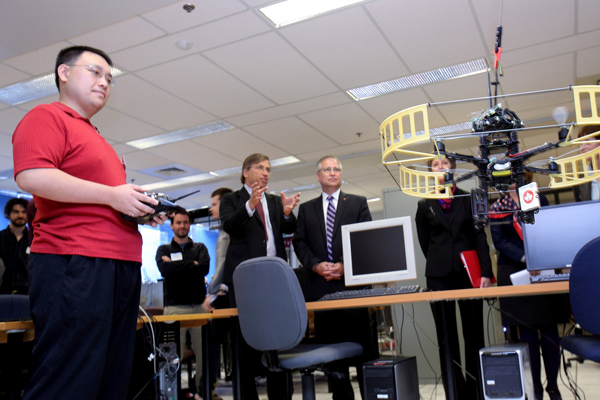Smarter Than C-3PO: Future Robots Will Work in Teams, Scientist Says

In the next few decades, teams of roving robots will take to the seas, the air and other hard-to-reach spots, communicating with one another and working to solve scientific problems, according to a Canadian scientist.
Such flotillas of smart machines could peer at coral reefs from underwater and in the air, or perhaps explore terrain that is difficult for humans to reach, said Gregory Dudek, research director of McGill University's mobile robotics laboratory in Montreal.
First, however, researchers will need to make sure the robots do not overwhelm the waiting humans with data. These robots should parse much of the information themselves and communicate the most interesting results to humans, sort of like a highlight reel from a sports game.
"It's getting a robot to go in some environment — on the surface, under the water, on the moon, wherever — and getting it to tell me what it sees," Dudek told the Canadian Science Writers' Association June 7 during its annual meeting.
One example, he said, could be an underwater robot that sends back the locations and types of coral that it views.
'This perception of C-3PO'
Last year, Dudek took on a new responsibility: leading the new NSERC Canadian Field Robotics Network. With the federal government and industry partners providing 5 million Canadian dollars ($4.91 million) in matching contributions, robotics scientists across Canada will work together on projects to advance research in the field.
Sign up for the Live Science daily newsletter now
Get the world’s most fascinating discoveries delivered straight to your inbox.
This work will culminate in an annual field test, in which robots will rove together underwater or on land, for applications ranging from monitoring oil pipelines to making real-time iceberg warnings.
At the conference, Dudek showed a video of a robot that could adjust to walking from the beach to swimming in the nearby water. He said advances in the field are making these machines smarter and faster. For instance, robots can perform multiple functions at the same time: walking, analyzing and sending back information.
The public, however, "has this perception of C-3PO" from "Star Wars" when talking about robotics, so it is difficult to convey how exciting this really is to researchers, Dudek said.
Networks of robots will need to balance how often they will meet and how often they'll work, he added. Regular contact will be essential to ensuring one robot isn't doing all of the assignments. For example, if two machines are exploring the city of Montreal, and one were to stumble into a dead end, resources should be reallocated, Dudek said.
Meeting, however, could involve long-distance technologies — the same ones as humans often use. Depending on the terrain, the robots could communicate using short-range radio, Bluetooth or even light beams. But talking shouldn't happen all the time, Dudek added.
"If we say, 'Let's meet very often,' it's not efficient, and you spend all your time in meetings," he said.
Follow Elizabeth Howell @howellspace, or LiveScience on Twitter @livescience. We're also on Facebook & Google+.

Elizabeth Howell was staff reporter at Space.com between 2022 and 2024 and a regular contributor to Live Science and Space.com between 2012 and 2022. Elizabeth's reporting includes multiple exclusives with the White House, speaking several times with the International Space Station, witnessing five human spaceflight launches on two continents, flying parabolic, working inside a spacesuit, and participating in a simulated Mars mission. Her latest book, "Why Am I Taller?" (ECW Press, 2022) is co-written with astronaut Dave Williams.









